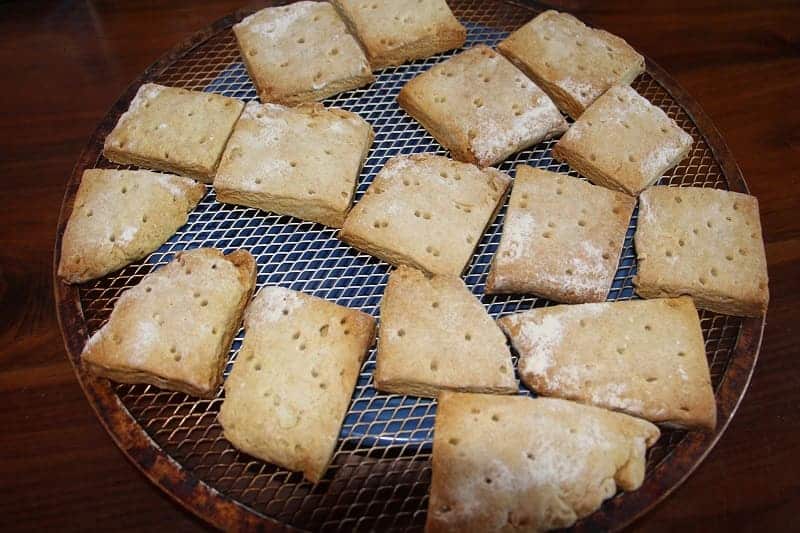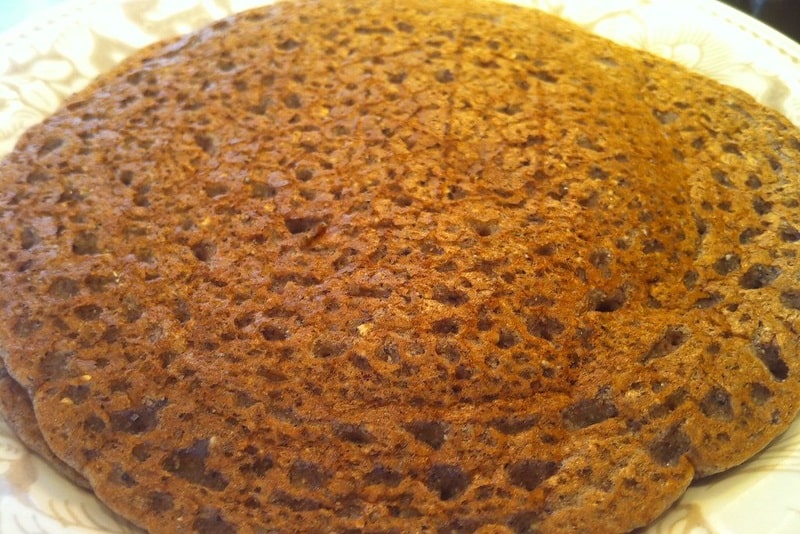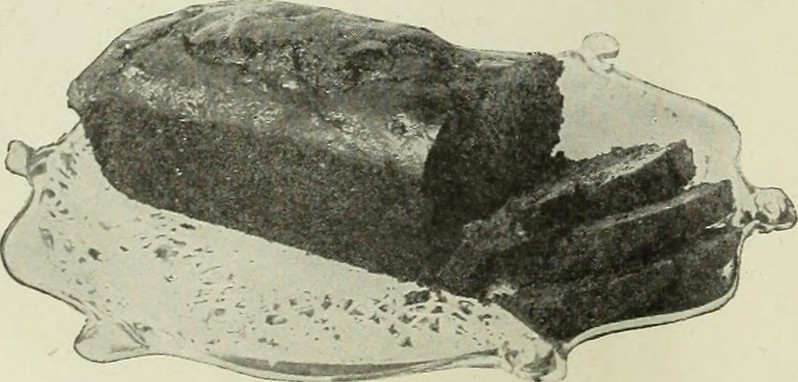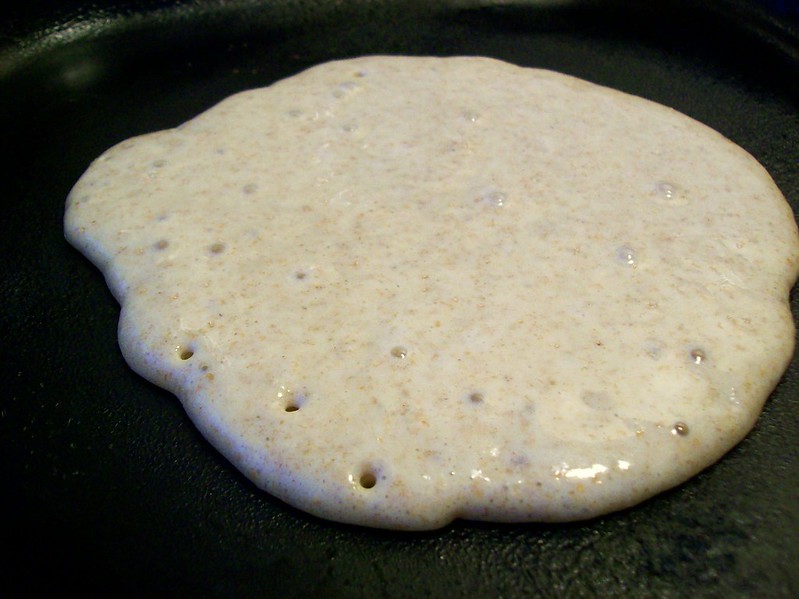How the pioneers ate is one of the most interesting aspects of their culture and heritage. It reveals how creative and hardworking they were in sustaining their families in challenging situations.
Below are some simple pioneer recipes that anyone can make.
Common Pioneer Foods
- Bread: The pioneers didn’t have packages of yeast. They usually made their bread with the “salt-rising” method. The bread dough was mixed in a kettle while they were traveling. Natural bacteria and microbes in the dough would cause it to rise. Then the dough was baked in the kettle over a campfire at night. Read more about it here. (Amazon link). Also read How to Make Wild Yeast Starter.

- Cured Meat: Without refrigerators, meat was preserved either by smoke or salt curing. To salt cure meat, salt was rubbed into the meat. The meat was then covered with salt for about 1 month, during which time more salt was continuously added. Bacon was a particular favorite of the pioneers.
- Cornmeal, dried corn: The pioneers brought dried corn and grinded it into meal to make cakes and cornbread. See, does cornmeal go bad?
- Lard: Forget fancy olive oil! The pioneers used fat from animals to cook their food. It was a staple on the trail. How to store lard long term.
- Eggs: Pioneers on the Oregon Trail did bring chickens along in crates tied to the backs of their wagons. However, it is doubtful that they laid eggs in the bumpy, stressful conditions. Eggs were mostly used in pioneer recipes once they got settled.
- Rabbit, squirrel, Turkey and other small game: These could be easily hunted along the way and made into stew. See our guide to eating squirrel.
- Squash: Squash, like pumpkins, doesn’t spoil quickly and can grow in the wild. The pioneers would make mashes and cakes out of them.
- Dried fruit: To dry fruit, pioneers would lay the sliced fruit out in the sun.
- Tubers (potatoes, turnips, etc.): These were also a pioneer favorite because they lasted a long time without spoiling. Tubers could also be foraged easily on the frontier.
Pioneer Recipes
Here are some authentic pioneer recipes and meals. We’ve also covered some of the techniques and traditions used in their rustic cuisine.
1. Hardtack

Also called “sea biscuit,” hardtack was eaten by pioneers, sailors, and soldiers during war. It is made of flour and water, mixed and baked for a long time in an oven. During bad times, the pioneers often had nothing to eat but hardtack dipped into coffee.
Recommended Reading: How to Make Hardtack
2. Hoecake

Pioneers brought along dried corn because it didn’t spoil. They could grind it into meal to make biscuits or “cakes.” For hoecake, mix the following ingredients and fry on a skillet:
- 2 cups cornmeal
- 1 cup water or milk
- ½ tsp baking powder
- ½ tsp salt
- 1 tbsp shortening
3. Pocket Yams
First, make a campfire. Once you’ve got enough coals, you can bake the yams (or potatoes). Cover the yams with the coals and let them bake until steam comes out – about 40 minutes. Note that the yams shouldn’t be in the flames, just in the hot coals.
When the yams are done, DO NOT EAT THEM.
These yams are meant to be put in your pocket to warm your hands. This is another cool way pioneer mothers kept their families warm in the wilderness.
4. Cooked Cabbage Salad
This recipe probably comes from German pioneers who particularly loved cabbage dishes. Make in a skillet:
- 1 pint of chopped cabbage
- 1 egg, beaten
- ¼ cup vinegar
- 1 tsp butter
- Salt and pepper
The pioneers might add sugar and a ½ cup of fresh cream to the cabbage if they had it.
5. Mormon Gravy
Gravy was slathered on top of vegetable pies, bread, or potatoes. It added much-needed flavor and moisture to the bland, dry food. To make it:
- Heat skillet with 3-4 tbsp of meat drippings (Amazon link)
- Add 3 tbsp of flour; stir constantly while browning the flour
- Remove from heat and add 2 cups of milk; stir
- Return to heat, stir constantly until mixture is smooth and thick
- Season with salt and pepper
6. Bread Pudding
The pioneers didn’t waste anything. So, they used stale bread to make bread pudding.
- 2 cups cubed stale bread
- 2 cups milk
- ¼ cup sugar
- 3 tbsp butter or lard
- 2 eggs
- Salt
Put bread in a baking dish. In a saucepan, mix milk, sugar, and butter. Remove from heat and whisk in eggs. Pour the mixture over the bread. Make at 350 degrees for 40 minutes.
7. Thrift Fritters
The pioneers didn’t always know what foods they’d find. For example, they might return from a foraging trip with a few wild carrots, nettles, and wild onions.
These random veggies could be added to old mashed potatoes, a beaten egg, and maybe some flour to make a fritter. Then, they would form the mixture into patties and fry them in drippings.
8. Butterless, Eggless, Milkless Cake

This sounds like a recipe for a health-food cake, but it is a pioneer classic!
- 1 cup brown sugar
- 1 cup cold water
- 1 1/2 cup raisins
- 1/3 cup shortening
- 1 tsp cinnamon
- 1/4 tsp nutmeg
- 1/2 tsp cloves
- 1/2 tsp salt
- 1 tsp baking soda dissolved in 2 tbsp of hot water
- 2 cups flour
- ½ tsp baking powder
To make, boil the first 8 ingredients (sugar through salt) together for a couple minutes. Then, add the baking soda, flour, and baking powder. Bake in a flat pan at 350 degrees for 40 minutes.
9. Tender Meat
The pioneers brought along cattle for milk and sometimes butchered them. The meat wasn’t exactly tender, either.
To tenderize the meat, they used this recipe:
- Mix 1 cup of fine breadcrumbs with some salt, pepper, thyme, or other herbs
- Add enough milk to make a very thick dressing
- Spread dressing over meat.
- Roll up the meat and tie it with twine.
- Brown the meat in fat.
- Add ½ pint of water. Cover and cook until the meat is tender.
10. Corn Soup
Dried corn was a staple of the pioneers. They made all sorts of things out of it, including soup.
The pioneer women would add whatever they had to the soup. For example, they might boil the dried corn with wild greens, potatoes, parsley, peppers, beans, eggs, and rice to make a hearty bowl of soup.
11. Bacon and Sourdough Pancakes

This one sounds good, right? It wouldn’t exactly pass modern health inspections, though, because the sourdough starter was made by leaving flour + water out for days. The bacteria in the air would cause it to ferment.
You can read more about how to make sourdough here. (Amazon link)
What will you cook if a disaster hits and wipes out the grid?


Actually Diane, I bake sourdough breads and believe sourdough starter ferments from the composition of the wheat itself and the wild yeasts and bacteria it contains. If left open, bacteria present in the air can cause a bloom of bad bacteria characterized by pink or black spots or liquid. A clear or gray liquid in unfed starter (discard) is called hooch (alcohol) and lends a nice tang to the discard when stirred back in and then some of discard is used for flavoring flat breads or pizza dough.
The amylase and protease enzymes feed the yeasts and fermentation begins within a couple of days. When fed, this can be maintained indefinitely. In fact just soaking flour and water overnight after forming into a dough will form gluten strands strong enough to trap gas and produce a rise when baked without kneading at all. Just add some leavening and bake.
Anyway double check that.
Additionally, I’ve seen a book “The Forgotten Ways” advertised that may be worth looking into that covers how the pioneers did many things from making pemmican to corning (salting) beef for preservation.
Hmmm… Not sure where you got that we said yeast comes from the air (though there is a lively debate about whether airborne microbes contribute to the formation of wild yeast starter). We’ve got this post about DIY yeast, though you already seem like a pro at it 🙂 https://www.primalsurvivor.net/how-to-make-yeast/
Sourdough starter uses the naturally occurring yeasts in the grains. Airborne bugs can ruin a good starter BUT if it’s mature, the beneficial yeasts destroy those anyway. Best to keep it covered regardless. AND you can use discard to quickly inoculate a fresh batch of starter. Discard is starving starter. It also imparts a nice umami when added to other doughs like pizza. I will feed and ferment my discard over night. Then, spread a thin layer on a baking tray lined with parchment which is laid over a single layer of paper towels (parchment is permeable) and dry it for a couple of days in a low oven. Then when FULLY dried, crush or grind it and either vacuum seal or Mylar bag with an O2 absorber and store the dried discard for a backup. It’s better than freezing as some do. But you then rely on the grid.
Dried then rehydrated and fed discard will rejuvenate in to almost its former vitality, and be ready to bake in 2-3 days.
All I know is that it’s more work than yeasted breads but the flavor of homemade sourdough bread is second to none which makes all the work disappear after the first bite.
My family came here on the Mayflower. I am related to Edward Winslow that was one of the signers of the Mayflower Compact. We have traversed this Continent from Plymouth Rock to California and from the Upper Great Lakes region to Florida. There have been a lot of stories handed down over the last 400+ years. One of the major misconceptions is that the Pioneers ate quite a bit of wild game while crossing the country. I assure you they did not. Most Wagon Trains averaged 20 to 40 wagons and 20 to 40 wagons lumbering across rough terrain makes for quite a bit of noise. Enough to scare away most anything in the immediate vicinity at least. And where the terrain permitted the wagons would fan out and travel abreast of each other to keep from eating dust all day long. Game is not going to stick around to watch a wagon train roll by. Hunters would have to travel for several miles away and ahead of the procession in order to find game and after the wagon route had been traveled a few times nearly all the game was depleted or ran off for miles in any direction so meat was in actuality pretty scares on a wagon train and what there was, was most generally in the form of jerky and bacon along with what is now days refer to as a country ham. The Oregon Trail left Independance, Missouri and was right at 2000 miles long. They averaged about 10 to 12 miles a day from sun up to sun down 7 days a week for six months. What cured meats were carried along were mostly eaten up in the first few weeks of travel and the rest of the trip was spent living on a starvation diet that would make a vegetarian long for a nice juicy steak…lol
Maybe I overlooked it but the one thing I see missing here in the recipes and comments alike is the flour used to make this stuff. I know flour is in the recipes but its not flour like the Pioneers would have used. If any or all of you are used to using self rising flour or even plain all purpose flour you’re not going to be making anything that calls for yeast if a real SHTF situation lasts for very long. The reason is because you can’t store yeast for long periods. Todays modern flour, ( SR and AP ) are both bleached which kills the wild yeast that occur naturally in the flour. Wild yeast even lives in the very air that we breathe but Bleached Flour is no a suitable environment for it to live in so if you’re going to make a really good sourdough starter you need to buy plain unbleached flour. ( Buy 5lb bags of Unbleached Flour, Put bag and all in a 1 Gallon Mylar Bag, drop in a 500cc Oxygen Absorber and then force as much air out of the bag as possible and zip it closed. ) When you need to make something that needs to rise you can used the UB flour for your sourdough starter. Everybody and their brother has a How to make Sourdough video on YouTube. I suggest you go there and learn how to make it.
I actually haven’t had a problem making yeast with white, bleached flour. I do need to make sure I use filtered water though since my municipal water supply has so much flouride, chlorine, etc. in it which kill the yeast.
Thank you
I appreciate your help and information please take care of yourself and your family.
Pemmican is pretty much just “beef jerky” (doesn’t have to be beef – any meat will do), although usually with cranberries or other stable vegetal ingredients added.
The combination of ingredients in pemmican actually helps it last longer, which is why it lasts longer than just plain beef jerky. 🙂
I’m trying to find out what it was that the early settlers ate that I believe they learned from the Indians . It got them through without starvation , it was made and ate all through the year and you could survive on this one thing.
Pemican? That’s the only thing that’s coke to mind…
Come to mind … Geeze I can’t type right now …
Sourdough “wouldn’t pass modern health inspection”? People still cook with sourdough, including very well-known bakeries who have had starters going for decades. Sourdough starter is made the same way it always was–there’s really no other way to make it. You can replicate the taste with sour salt, but there’s no shortcutting actual sourdough.
Yikes, what a statement.
The comment isn’t meant to imply that sourdough is unsafe. It’s to point out why sourdough isn’t common anymore. Have you seen how strict the health inspection rules are for bakeries and other food businesses? Everything has to be controlled. My friend owns a bakery and it was a huge hassle to make sourdough under these restrictions.
Cooked Cabbage Salad is tasty!
Everything old is new again. This recipe is all over the keto recipe sites as carb-less hash browns and it IS very potato-like. Don’t wait till hard times this is good, healthy stuff.
Modern sourdough starters are made the same way! Although the thing that makes a sourdough starter work is actually wild yeast, which is found in the flour as well as the air all around it. Yeast is a type of fungi, not bacteria!
My mother also made the eggless, milk less,
Butter less cake…. but it didn’t have cinnamon in it
Do you have a wood stove?? I always made my baked beans on top of the wood stove and cast iron pans are a great way to cook on a wood stove.
I used to have a wood stove when I still lived in the country. I miss it. Though, admitedly, I don’t miss waking up to a freezing cold house after sleeping in too long (and fire going out) on weekends. 😀
Ya gotta cowboyup
On Thrift Fritters, do you mean “with a beaten egg and some” flour? It says “some patties”.
Good catch — thank you. I’ve fixed it. You can actually make fritters with just potatoes. Or with just wheat flour, corn flour, old breadcrumbs, rice, or almost any other starchy food (yams, parsnips, beans…). I make fritters all the time to get rid of leftovers and they are different every time. 🙂
What good is an e-book if the technology is no longer available to access it? Why not a hard copy?
Hard copies are always better. You can print PDFs to have on hand and build your own “survival library” to have in case the grid is down.
I’ve been thinking this would be very wise
Hoe cake recipe needs water to make the batter
So, silly question but how do you bake without an oven? If we loose electric all I’ll have will be a Coleman camp stove.
There are a lot of different solutions, like building a hearth oven out of clay, solar ovens, or a dutch oven on a bed of hot coals. I’ve also found that grilled and fried bread is awesome — even better than traditional baked bread. I guess we should write a post on all of this!
Coleman, among other manufacturers, makes a fold-up camp oven which is heated atop their regular camp stove (or coals, if you happen to have a good bed of them).
I haven’t had occasion to use this sort of thing in literally decades, but the Coleman oven, although smallish, turned out breads, cakes, pies, roasted meats and just about anything else one would cook in a home oven, as long as it would fit in a barely more than 1-foot cube oven.
You can also make one out of a cardboard box and foil.
Girl Scout handbook from 1960’s or 70’s. Put warm coals in the bottom and cover to bake.
Dutch ovens are amazing. You can cook anything in them from souffle to bread. There is a International Dutch Oven Society (IDOS) that still holds competitions annually. Hundreds of cookbooks with ideas of what and how to cook. It is one of the most fun ways to cook food when you are camping.
I’ve been reading a lot of first-person accounts –diaries, journals, letters– of those who traveled into the unknown territories in the 1800s, homesteading incredibly close to the Earth and often raw deprivation was the rule.
Thus many homesteaders would make a Hunter’s Sauce for their wild game… either the German version (creamy, often with mushrooms and bacon) or (cloyingly, IMO) sweet with a tomato and alcohol base. It (almost) covered the gaminess and often helped tenderize the game.
When I attended a Wild Game Dinner at the Yale Club in NYC, they served both types of Hunter’s sauce and it was critical to being able to choke down some of the game offered.
Sorry, that above comment was about the cake recipe.
Flat pan? Is it like the pan you would use to bake a cake that you’re going to roll into a log cake?
Claire…
I checked other Depression- and war-era ‘Butterless, Eggless, Milkless Cake’ recipes and many/most appear to use either 8″ or 9″ square pans or a 9″x13″ pan.
I think you are speaking of a baking sheet. I believe the recipe calls for a baking pan with sides. Just my thoughts.
I actually remember my grandmother making the butterless, eggless, and milkless cake when is was a kid (not too long ago, I am a Gen X’er), and it was delicious. But this makes sense as she migrated across the SW in the early 1920’s.
Great memories to have.